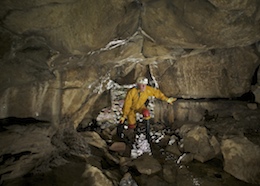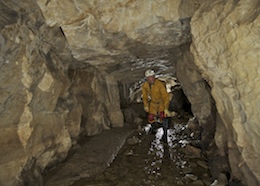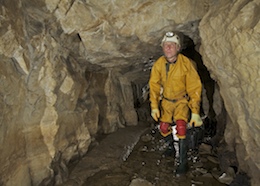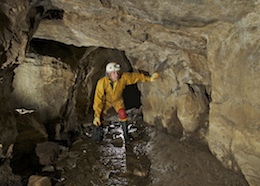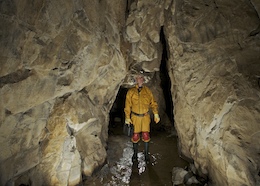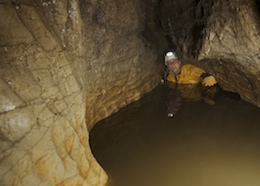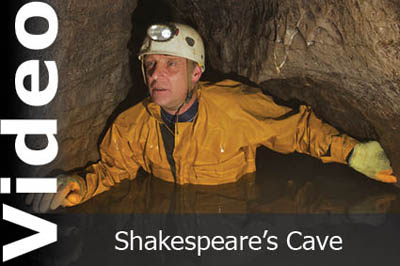Overview
Shakespeare's Cave is a short but wet and sporting cave located in the Clydach Gorge. With other short caves located in walking distance from this one, it generally makes part of an itinerary for a warm Summer's Day.Length 365m
Altitude 206m
Grid SO 21700 12490
History
This cave has long been known and is said to form the inspiration for Shakespeare's Midsummer Nights Dream as the home of the Fairies. The entrance has three pointed slots radiating above it giving it a magical appearance. There is evidence of quarrying in the entrance passage, possibly the reason for this section of cave being of much larger proportions to the rest of the cave. The cave was first described by Brian Price in 1946 ending at a sump, which is now the first duck. At Easter 1964 Colin Graham and Michael Jeanmaire passed two sumps, one of the sumps having now been made into a now duck, to extend the cave by 200m.
Location
Shakespeare's Cave is best reached by passing Ogof Capel and heading down to the river in the gorge which can be easily crossed in low water conditions to reach a small tributary gorge - Cwm Pwca - Valley of the Goblins on the opposite side. Heading up this tributary for 50m Shakespeare's Cave is found located on the left, in the base of a rock face. Clydach Gorge Google map showing the location of Shakespeare's Cave and other caves in the area.
Location map - click marker to show entrance photo
Access
No known access controls.
Description
The cave is the resurgence for the water from Llanelly Quarry Pot located higher up in the Clydach Gorge. The entrance to this wet and sporting cave is a low arch with water issuing to the side of it. This chamber leads to a rift passage after 20m with water emerging from it. This narrow passage is followed as it meanders to the first duck, which has a short low airspace, but plenty of space under water allowing easy passage. Beyond the duck, the passage continues with sections of deeper water to lead to the second and third ducks. These are tighter than the first duck and present more of an obstacle. A short distance beyond these, a fork in the passage is reached. The stream issues from the left and can be followed for another 20m to reach sump 1.Sump 1 is about 2 metres long and emerges into a section of passage with a narrow airspace, followed by a duck. The sump has rock projections that can catch on clothing and is easy to overshoot. A rope through the sump acts as a guideline for those attempting to pass it. Back at the fork to the right is Stratford's Bypass, an alternative route avoiding Sump 1. This starts as an ascending tube that leads up to a large slippery boulder that has to be squeezed over. Beyond the passage continues as a muddy crawl past a couple of side passages. Keeping to the main passage eventually finds it descending to meet a T junction. At this junction, to the right ends when it become too narrow to continue, while to the left brings you to the fifth duck. This is very tight and can silt up, this duck is best attempted on your back feet first being aware that the passage takes a sharp turn to the left. Beyond the duck is Quarter Century Passage, where the passage soon reaches deeper water. Following the water downstream leads to the fourth duck and the other side of Sump 1 beyond. The passage can be followed upstream for some distance as a rift passage. A climb over boulders into the roof of the rift allows you after a few metres to climb up into a chamber. The last section of passage is a narrow rift that becomes too tight, at this point a waterfall can be heard just beyond. The end of Shakespeare's Cave is very close to the sump at the end of Llanelly Quarry Pot.
Tackle
A wetsuit is advised.
Video
References
Cambrian Cave Registry entry for Shakespeare's Cave UKcaving Wiki entry for Shakespeare's Cave
Caves of South Wales | Tim Stratford | ISBN: 0904405354 | Published by Cordee
The Caves of Clydach | Tony Oldham
British Caver - No 15 | Brian Price
A Caver's View of the Clydach River | Theo Schuurmans | Cwmbran Caving Club
Warnings
The cave is wet with a number of ducks and a sump and should be avoided in times of high water levels.Sump 1 although short has rock projections that may catch on clothing, it is also easy to overshoot.
Disclaimer
The photographs and information of this page has been provided to help cavers planning trips. Caving can be a dangerous activity, if you are interested in exploring caves please join a caving club so you can enjoy a safe introduction to this sport. Local caving clubs are listed on the links page or you can visit the 'New To Caving' website for more options.If you feel that any of the information is incorrect or should be updated please contact us.


